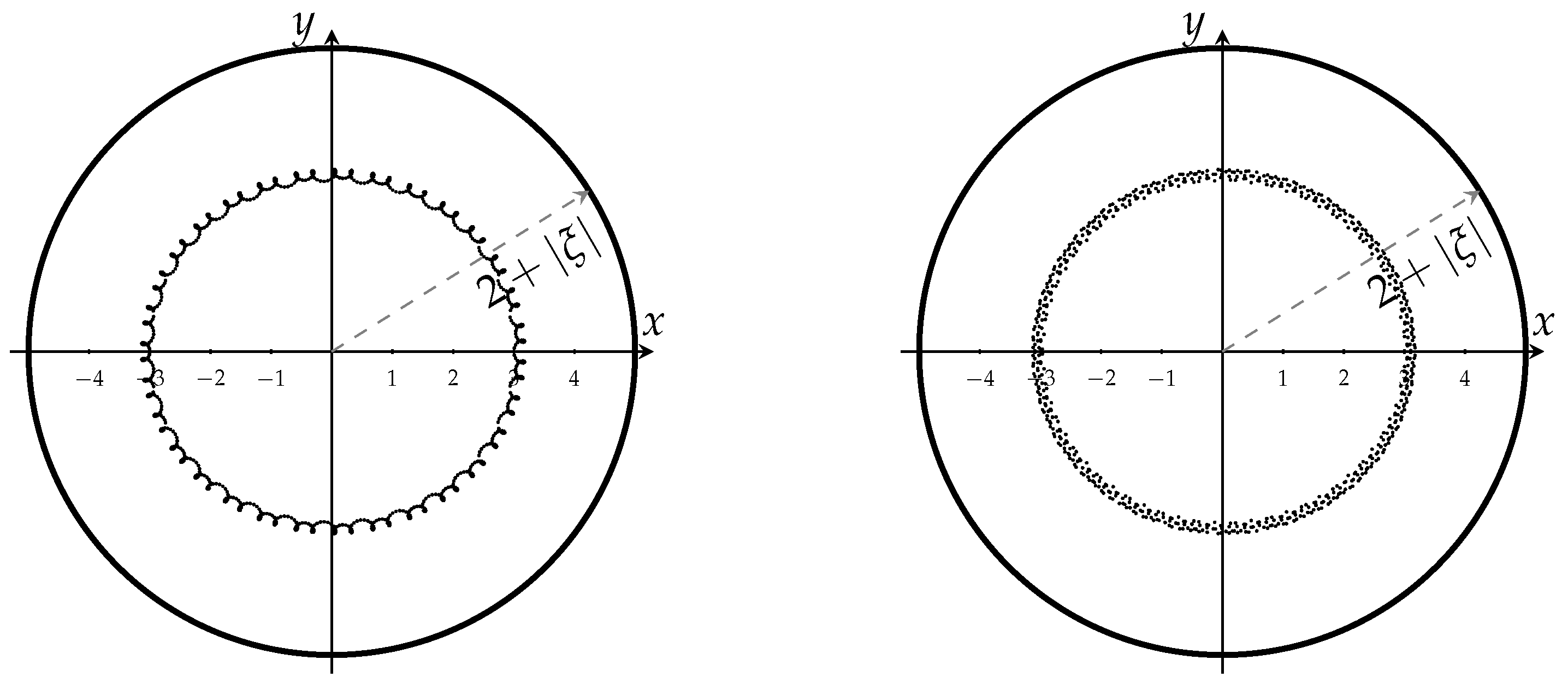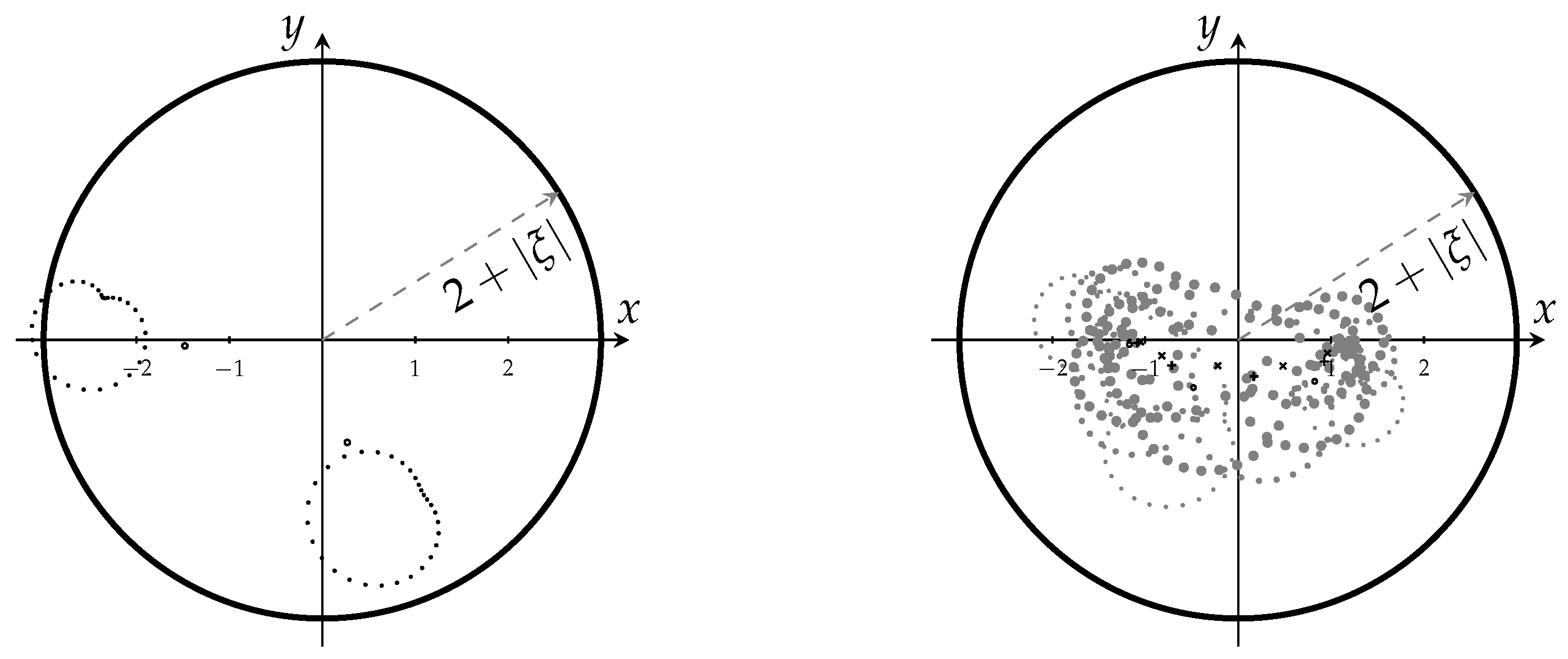On Polar Jacobi Polynomials
Abstract
:1. Introduction
2. Algebraic Properties of the Polar Jacobi Polynomials
- 1.
- Three-term recurrence relation.with initial condition , and recurrence coefficients
- 2.
- First structure relation.with coefficients
- 3.
- Second structure relation.
- 4.
- Squared Norm. For every ,
- 5.
- Second-order difference equation. For every ,
- 6.
- Forward shift operator.
- 7.
- Asymptotic formula. Let . Put where the branch of the square root is chosen so that for . Then,where is a function of α and β and x independent of n. The relation holds uniformly on compact sets of .
3. Zero Location
- 1.
- If is a zero of , then is a zero of .
- 2.
- If is a zero of , then ζ is a zero of .
- 3.
- The zeros of have multiplicity of at most 2 and their multiple zeros are located on .
- 4.
- All the zeros of are located on the curve
- Observe that the zeros of do not have to be simple. Let or ; then, the polar polynomial of degree two , or .
- When the parameters are not standard, i.e., or then, by Corollary 2, statement 3 of Theorem 6 is no longer true. For example, if , , and , then .
- 1.
- All zeros of the polar Jacobi polynomials with pole ξ are contained in .
- 2.
- If , the zeros of the polar Jacobi polynomials with pole ξ are simple and contained in the exterior of the ellipse , where .
Funding
Data Availability Statement
Conflicts of Interest
References
- Martínez-Finkelshtein, A. Analytic aspects of Sobolev orthogonal polynomials revisited. J. Comput. Appl. Math. 2001, 127, 255–266. [Google Scholar] [CrossRef]
- Lagomasino, G.L.; Español, F.M.; Cabrera, H. Logarithmic asymptotics of contracted Sobolev extremal polynomials on the real line. J. Approx. Theory 2006, 143, 62–73. [Google Scholar] [CrossRef]
- Marcellán, F.; Xu, Y. On Sobolev orthogonal polynomials. Expo. Math. 2015, 33, 308–352. [Google Scholar] [CrossRef]
- Cohen, E.A., Jr. Theoretical properties of best polynomial approximation in W1,2[−1, 1]. SIAM J. Math. Anal. 1971, 2, 187–192. [Google Scholar] [CrossRef]
- Koekoek, R. Generalizations of Laguerre polynomials. J. Math. Anal. Appl. 1990, 153, 576–590. [Google Scholar] [CrossRef]
- Bavinck, H.; Meijer, H.G. Orthogonal polynomials with respect to a symmetric inner product involving derivatives. Appl. Anal. 1989, 33, 103–117. [Google Scholar] [CrossRef]
- Bavinck, H.; Meijer, H.G. On orthogonal polynomials with respect to an inner product involving derivatives: Zeros and recurrence relations. Indag. Math. New Ser. 1990, 1, 7–14. [Google Scholar] [CrossRef]
- Alfaro, M.; Pérez, T.E.; Piñar, M.A.; Rezola, M.L. Sobolev orthogonal polynomials: The discrete-continuous case. Methods Appl. Anal. 1999, 6, 593–616. [Google Scholar] [CrossRef]
- Jung, I.H.; Kwon, K.H.; Lee, J.K. Sobolev orthogonal polynomials relative to λp(c)q(c) + 〈τ,p′(x)q′(x)〉. Commun. Korean Math. Soc. 1997, 12, 603–617. [Google Scholar]
- Kwon, K.H.; Littlejohn, L.L. Sobolev orthogonal polynomials and second-order differential equations. Rocky Mt. J. Math. 1998, 28, 547–594. [Google Scholar] [CrossRef]
- Kuijlaars, A.B.J.; Martinez-Finkelshtein, A.; Orive, R. Orthogonality of Jacobi polynomials with general parameters. Electron. Trans. Numer. Anal. 2005, 19, 1–17. [Google Scholar]
- Pijeira Cabrera, H.; Bello Cruz, J.Y.; Urbina Romero, W. On polar Legendre polynomials. Rocky Mt. J. Math. 2010, 40, 2025–2036. [Google Scholar] [CrossRef]
- Aptekarev, A.I.; López Lagomasino, G.T.; Marcellán, F. Orthogonal polynomials with respect to a differential operator. Existence and uniqueness. Rocky Mt. J. Math. 2002, 32, 467–481. [Google Scholar] [CrossRef]
- Borrego-Morell, J.; Pijeira-Cabrera, H. Orthogonality with respect to a Jacobi differential operator and applications. J. Math. Anal. Appl. 2013, 404, 491–500. [Google Scholar] [CrossRef]
- Borrego-Morell, J.; Pijeira-Cabrera, H. Differential orthogonality: Laguerre and Hermite cases with applications. J. Approx. Theory 2015, 196, 111–130. [Google Scholar] [CrossRef]
- Borrego Morell, J.A. On orthogonal polynomials with respect to a class of differential operators. Appl. Math. Comput. 2013, 219, 7853–7871. [Google Scholar] [CrossRef]
- Pijeira-Cabrera, H.; Rivero-Castillo, D. Iterated integrals of Jacobi polynomials. Bull. Malays. Math. Sci. Soc. 2020, 43, 2745–2756. [Google Scholar] [CrossRef]
- Olver, F.W.J.; Olde Daalhuis, A.B.; Lozier, D.W.; Schneider, B.I.; Boisvert, R.F.; Clark, C.W.; Miller, B.R.; Saunders, B.V.; Cohl, H.S.; McClain, M.A. (Eds.) NIST Digital Library of Mathematical Functions, Release 1.2.1 of 2024-06-15; National Institute of Standards and Technology: Gaithersburg, MD, USA, 2024.
- Lucas, F. Theorems on algebraic equations. C. R. Acad. Sci. 1874, 78, 431–433. [Google Scholar]
- Borwein, P.; Erdélyi, T. Polynomials and Polynomial Inequalities; Graduate Texts in Mathematics; Springer: New York, NY, USA, 1995; Volume 161, pp. x+480. [Google Scholar] [CrossRef]
- Szegő, G. Bemerkungen zu einem Satz von J. H. Grace über die Wurzeln algebraischer Gleichungen. Math. Z. 1922, 13, 28–55. [Google Scholar] [CrossRef]


Disclaimer/Publisher’s Note: The statements, opinions and data contained in all publications are solely those of the individual author(s) and contributor(s) and not of MDPI and/or the editor(s). MDPI and/or the editor(s) disclaim responsibility for any injury to people or property resulting from any ideas, methods, instructions or products referred to in the content. |
© 2024 by the author. Licensee MDPI, Basel, Switzerland. This article is an open access article distributed under the terms and conditions of the Creative Commons Attribution (CC BY) license (https://creativecommons.org/licenses/by/4.0/).
Share and Cite
Costas-Santos, R.S. On Polar Jacobi Polynomials. Mathematics 2024, 12, 2767. https://doi.org/10.3390/math12172767
Costas-Santos RS. On Polar Jacobi Polynomials. Mathematics. 2024; 12(17):2767. https://doi.org/10.3390/math12172767
Chicago/Turabian StyleCostas-Santos, Roberto S. 2024. "On Polar Jacobi Polynomials" Mathematics 12, no. 17: 2767. https://doi.org/10.3390/math12172767




